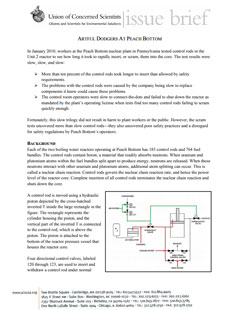In January 2010, workers reduced the power level of the Unit 2 reactor at the Peach Bottom nuclear plant in Pennsylvania to time how long it took control rods to fully insert into the reactor core. Safety studies assume the control rods will insert within a short time period to stop the nuclear chain reaction to mitigate the consequences of an accident. The tests revealed that three of the 19 control rods tested took longer than assumed.
The operating license issued by the Nuclear Regulatory Commission (NRC) for Peach Bottom Unit 2 was very clear on what to do in this situation: test additional control rods until the percentage of slow ones dropped below 7 percent. But as additional contol rods were tested, more slow control rods were found.
The cause of the slow control rods was soon traced to a flawed component its vendor offered to replace for free back in 1997. The company did not take advantage of that offer and the faulty components adversely affected several control rods.
The operating license required that the reactor be shut down promptly if more than 13 control rods were slow. By the time workers finished testing all 185 control rods (the testing never dropped the percentage of slow ones below 7 percent), a total of 21 control rods tested slow. But Unit 2 was not shut down promptly.
Instead, workers slowed down the pace of the testing to match the pace of fixing slow control rods. By doing so, the number of slow control rods at any time stayed below 13.
The workers at Peach Bottom artfully—and likely illegally—played games with safety and operating license requirements to keep the Unit 2 reactor operating despite known safety shortcomings.
An effective regulator would severely sanction such unsafe practices. What will the NRC do?




